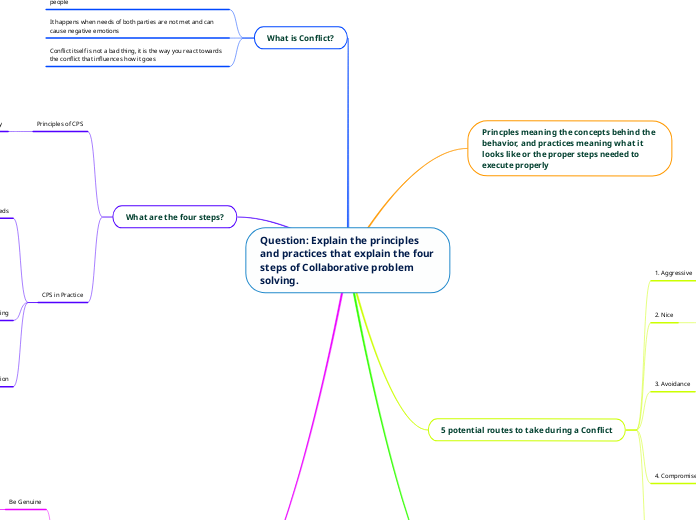Question: Explain the principles and practices that explain the four steps of Collaborative problem solving.
Practices involved in the steps
Be Assertive
Do not give in to the other person and do not agree to something you are not okay with, keep working until you find something that meets the needs of both people
You must be able to assert your needs without disrespecting the other person, but also do not allow them to walk all over you.
Use I Statements to describe how you feel
While it is important to understand other's needs, it is equally as important that others understand your needs.
Show Empathy
It makes them feel like you understand how they feel and will make them want to cooperate.
It is important to understand that you are not the only person feeling negative emotions. Finding a common struggle that both parties can relate to can make the other person feel better.
Don't interrupt, listen and summarize, repeat back to them what they said and allow them to correct you
Practice Empathetic listening
A conflict is only possible when two or more people come to a disagreement; both sides feel wronged and it creates tension between the two.
Be Genuine
Conflict resolution is a team act and you must have an understanding of the other person in order to come to a resolution.
Show interest in the other person's feelings and make them feel respected. Listen to what they have to say rather than thinking about what you are going to say next.
What are the four steps?
CPS in Practice
Step 4 CPS: Select a Solution
The solution should be a maximum gain, or have the most pros and fewest cons for both people.
After brainstorming, you should select a solution that meets the most needs for both parties
Step 3 CPS: Brainstorming
Do not be afraid to suggest a solution no matter how ridiculous, list anything that could potentially solve the problem.
Brainstorm collaboratively to create new solutions. After identifying the needs of both parties, brainstorm solutions that meet both needs.
Step 2 CPS: Identifying needs
Express your needs without blaming the other person and take their needs into consideration.
I-stateements not you states
What are you-statements?
Describing how you feel and blaming the other person for it
ex. You make me so sad!
What are I-Statemetns
I statements are a way to describe how you feel without putting blame on the other person.
ex. I feel sad when I feel I am not being treated right.
2. Identify the needs of each party, listen compassionately and understand the needs of yourself and the other person.
Practice empathetic listening and be genuine towards the other person, allow them to get their ideas out and show them that you care.
Principles of CPS
Step 1 CPS: Connecting to Humanity
Show the other person you care for their needs and it can incline them to be more cooperative
MP: Connecting to the humanity of the other person means seeing the other person as a human with needs and respect them.
Show compassion and respect for the other
What is Conflict?
Conflict itself is not a bad thing, it is the way you react towards the conflict that influences how it goes
It happens when needs of both parties are not met and can cause negative emotions
A conflict is an altercation or argument between two or more people
My conflict
My c
5 potential routes to take during a Conflict
5. Collaborative Problem Solving
It only requires one person to be able to find the route of the issue and suggest solutions. This way of thinking is very effective for solving conflicts and allows for a peaceful resolution where the needs of both parties are being met.
this way of thinking revolves around the idea of separating needs from positions. Instead of focusing on the specific request of the other party, find the need that motivates that request and create unique solutions to meet that need.
4. Compromise
Sometimes within compromises it is not possible to meet the entire needs of both parties depending on the situation. Compromises are a very effective solution to conflicts, but they do not work for all.
This is a very effective approach that works best when both parties are open to solutions. By compromising, both parties are able to have some portion of their needs and is a positive resolution.
3. Avoidance
Avoidance is one of the worst things you can do for a conflict. It makes the other person feel like you do not care for their feelings and usually causes more problems than it fixes.
conflict can be overwhelming for some and cause people to avoid it. This behavior is not so much as them not caring but more as they do not know what to do, because of this they feel like the best idea is to leave it alone.
2. Nice
gives in to the other person and allows them to get their way, leaves them unsatisfied and creates and unhealthy relationship.
1. Aggressive
takes charge of the situation and fights, does not give in until needs are met, this type of conflict always ends with a winner and a loser.
Princples meaning the concepts behind the behavior, and practices meaning what it looks like or the proper steps needed to execute properly









